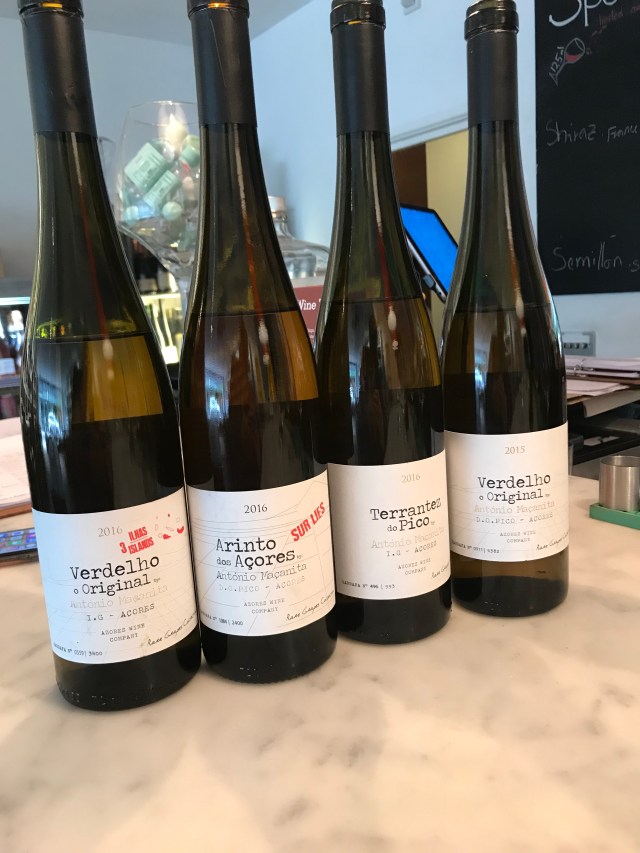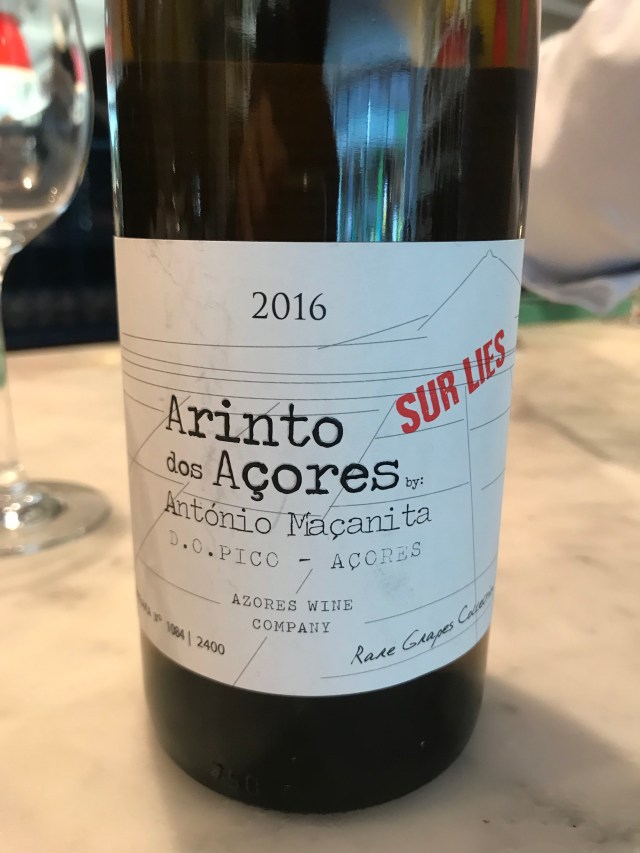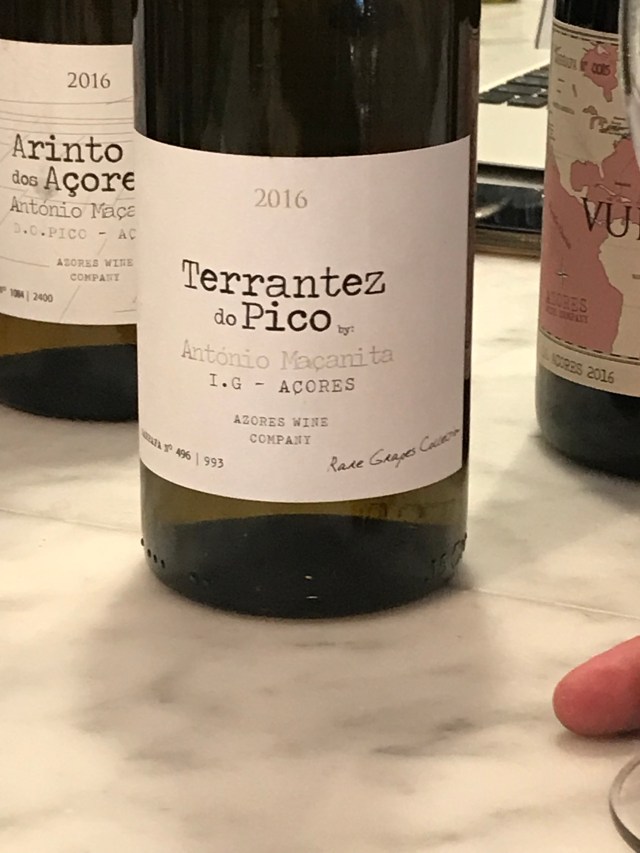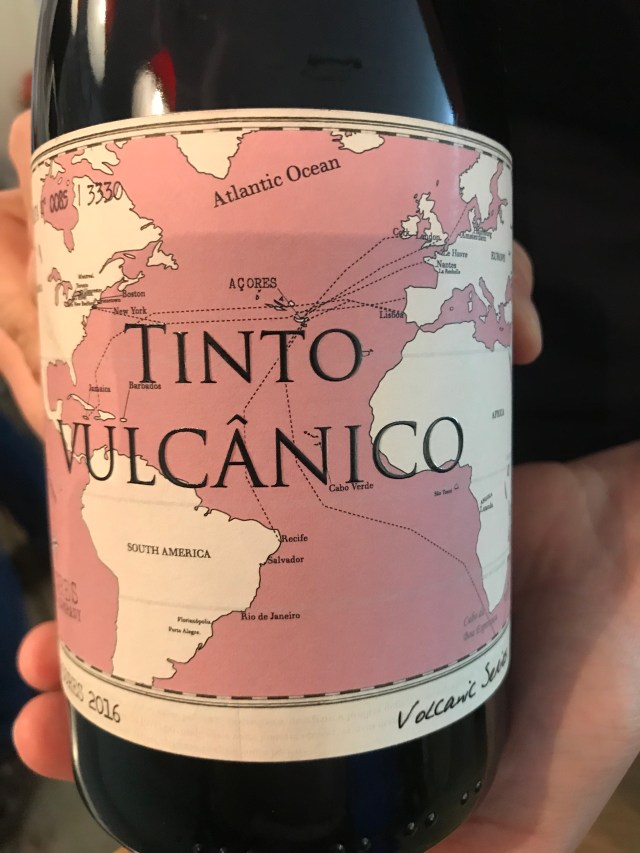There was a buzz being created around the Azores even before Sarah Ahmed wrote a revealing article in Decanter last summer, and that buzz has without doubt been created largely by one man, António Maçanita, the founder (with Paulo Machado) of the Azores Wine Company. Today I had the chance to meet António at Ten Green Bottles in Brighton, to listen to his story, and for the first time to taste the whole AWC range in one sitting.

António Maçanita with Lisanna from Azores Wine Company’s UK importer, Red Squirrel
Most people are vaguely aware of where the Azores archipelago is situated, but perhaps many place it much closer to the Canary Islands, and Madeira, which have a warmer climate. The Azores actually sit almost a thousand miles west of mainland Europe, effectively a third of the way to America. They sit right on top of the North Atlantic Ridge, the great underwater fault line which splits the Atlantic Ocean. As America pulls away from Europe (at a rate of a couple of centimetres a year), magma is forced up through the split in the earth, and the Azores is a nine island consequence, made from pure volcanic rock.
Many of the islands which make up the Azores are very old, in most cases numbering millions of years. Fertile volcanic topsoils have formed, providing rich agricultural land. On Pico, the main island for viticulture, which is a baby of merely 300,000 years in comparison, there is almost no topsoil. The only productive agriculture on any scale is viticulture, but viticulture of a very unusual kind. Vines are planted in the cracks of the rock, from the very sea shore up to around 200 metres altitude. The clouds are drawn up the side of the 2,350 metre Pico volcano which dominates the island, leaving a sunny zone below. António repeated an old saying, “where the crabs are singing (in the sun) you find the best vineyards”.
If a sun-drenched island idyll is in your mind, you are wrong. António said it rains every day, perhaps an exaggeration, but with temperatures maintained around twenty degrees and a lot of rain, rot in the vineyard is a constant threat, yet there is a a determination to avoid synthetic vine treatments. The only answer is to raise the vines when they need ventilating, and to lower them behind protective walls when a storm is coming in. The threat of losing a whole year’s crop is constant and stressful.
The vines on Pico are protected from both the atomised sea salt spray, and the ocean winds which burn the vines, by low walled enclosures called currais. These structures are essential to any form of viticulture, and there are around 6,000 hectares of original vineyard protected in this way, an almost unthinkable feat for the early inhabitants to build. From aerial photos they look like the ruins of some ancient civilisation, but in reality they are a few metres more or less square, each adjacent enclosure protecting two or three plants. The only places I know of where vines are similarly protected would be in parts of the Canary Islands, and in parts of Santorini. Today there are just 150 hectares in production on Pico, and much much less on the other islands.
The story of Azores wine begins in the 1400s, even before the European discovery of America, but after that event the islands became a regular stop on the slow transatlantic crossing. Prosperity followed, and Pico turned into an export economy, though much of the islands’ wines ended up in America labelled as Madeira. The golden age was in the early to mid-1800s, with the Azores producing twenty-five times more wine than Madeira. Then, in 1854, disaster struck, first in the form of powdery mildew, and then phylloxera in 1857. After the vineyards were decimated two thirds of the population emigrated to America, despite the switch from wine to whaling providing some subsistence for those who remained. Then the lights were switched off…

Until 2010 when António came to the islands, initially with his experienced consultancy hat on. But when only one winemaker employed him, he decided to start his own project and the Azores Wine Company was born. The first vintage was 2014, and the wines are imported into the UK by Red Squirrel. Quantities are tiny, and the prices are not cheap.
But remember the costs of production, the small scale, and above all, the fact that you are buying unique wines from a UNESCO World Heritage Site (this very special viticultural landscape attained a UNESCO Listing in 2004). These are wines which are a true reflection of the local volcanic soils, from remote vineyards lashed by the wild Atlantic. What true wine lover wouldn’t want to buy into a little part of that?
Verdelho Original 2015, DO Pico
Saline, herby and fresh, this is a cool climate wine off volcanic terroir pure and simple. With 13% abv it is slightly broader than the nose suggests, slightly closed, with a nice stony texture and mouthfeel. You immediately understand that you don’t want to serve these wines too cold, just cool. The development in the glass as the wine opens is very noticeable.

Verdelho Original 2016, DO Pico
The 2016 is a slightly brighter version of the 2015, and is a “three island blend” due to a very small 2016 harvest. Acidity is a touch fresher and it is more open for business from the off. António called it “seductive”, and it certainly is. Which of the two do I prefer? Hard to say. The 2016 is perhaps more immediately appealing, but I do have a bottle of the 2015 at home, as yet unopened. I’m looking forward to pairing it with food, where I think it will shine.
Arinto dos Açores “Sur Lie” 2016
This is also made from grapes from three islands, Pico, São Miguel and Graciosa (the latter of which only has around five hectares in production). This strikes a high note with its bouquet, very elegant and with a mineral whiff. The palate is more citrus than the Verdelho, but there is a very nice fruit to acid balance with the Arinto (a completely different grape to the Arinto found on the mainland). As a 13%er it has a little bit of muscle, but it is lightened and lifted by its acidity. Delicious. Arinto is the Azores’ most widely planted variety.

Terrantez do Pico 2016
As with Arinto, this is not the same grape variety as the Terrantez from Madeira. The nose here is immediately interesting, both herbal and mineral at first, and then as it broadens a gentle floral note comes through. Again, it is asking or indeed crying out, please, not to be served too cold, which would kill the subtlety.
Terrantez was almost extinct when it was revived from just 89 original plants by AWC. Now they have 3 hectares, propagated by massal selection, and they make between just 800 to 900 bottles. It is, thus far, the only Terrantez wine in the Azores.

Tinto Vulcânico 2016
This 11.5% abv red wine is a blend of many different local varieties. António and Paulo originally only planned to make white wine, but local growers would bring along their red grapes, and they decided to try out a red cuvée, almost as an afterthought. The blend changes every year, by its nature, and the grapes come from around thirty or so plots on the island.
The fruit in 2016 was destemmed and underwent a wild/natural fermentation, mainly in a single tank, with grapes arriving in small quantities at different times. It saw around twenty days in total on skins. The result is a simple wine in some respects, yet unquestionably one with character and personality.
The nose at first shows quite amazing fruit concentration, like that in just ripe blackcurrants, where the fruit is matched punch for punch by the acidity. But as the low alcohol suggests, this is by no means a big wine. There is some bitter extract which adds something over and above the fruit dimension, and the fruit flavours linger, carried on the back of the acidity. This wine is very appealing in what has become the traditional glouglou sense, among the seekers of adventure in wine. Nice, and explanatory, label too.

A Proibida [2013]
This final red wine has a bit of a chilling story. The grape variety here was thought to be Isabella, an American hybrid vine planted as a solution to that powdery mildew epidemic which devastated the original Azores vineyards in the mid-nineteenth century.
António found himself invited to a gathering of Azores wine people and an old farmer produced a jug of red wine. On tasting it, António thought wow! So he decided he had to make some. On placing the resulting wine on the market he was contacted by the authorities who pointed out that the Isabella variety is actually illegal within the EU, where American hybrid vines are banned. This is because, quite reasonably really, they don’t usually make wines of the same quality as vinifera varieties (although some hybrids are now making wine in the very north of America to challenge our preconceptions). He was told that if he did not remove the wine from the market he would face a fine and possibly prison.
António was forced to explain that Isabella was not in fact the varietal name, but the wine is named after Queen Isabella and made from a host of different, unknown, local grapes. It is now labelled with any mention of Isabella struck through, as if censored, and also stamped with the words “Autorizado com Cortes“, or “Authorized with Cuts”, which refers to the stamp used by the censors under Portugal’s Salazar dictatorship.
Why does this wine deserve our attention? Fine wine it certainly isn’t. Indeed, it more accurately represents the idea of a “tavern wine”. The first thing you would say is that this is a wine which speaks initially, and forcefully, through aroma. It has the so-called foxiness of a vitis labrusca hybrid, although perhaps not as strongly as some examples, and it also has a smoky note, which is not unpleasant. The palate is that perfect blend of high toned fruit and high acids (it is more acidic than any of the whites). If you don’t think it is possible somehow to combine notes of black olives and strawberries in a pleasant beverage, this is how to do it. Amazing!
I’m guessing that I’m not painting an immediately appealing picture, but unless your thing is high alcohol jammy Merlot, please persevere. António really hit the nail on the head when he called it a “twenty-second century wine”. If we want wine not to sip and admire, but to glug back as we might enjoy a beer, then this “tavern wine”, made with minimal intervention, is just the sort of thing we might want to try. If, like many people, you are re-evaluating what wine means to you, then this will not be your answer, but in appreciating something so different, it will help you on your journey. It paints a picture of what wine once was, and what, with a modern updating, it might be.

As an aside, Isabella (the hybrid, not the queen) is often preceded with something like the descriptor “notorious”. It is particularly despised in Europe, or at least was, because it is thought that it was on a batch Isabella vines that the phylloxera louse first came to Europe from America. Let’s not blame the vine for vastatrix.
Like the wines of the Azores as a whole, Proibida may not be the finest bottle you try this year. You may also think that the price is not inexpensive for what it is, and what it tries to be (the answer to which is that it doesn’t try to be anything). Yet with all of these wines, you are tasting a range of genuine character, where terroir expression is real, not just some marketing verbage. They are clearly and genuinely “volcanic wines”, created by a thoughtful and fully engaged, highly competent (and, I think, soulful) practitioner.
In fact I liked these wines ever since I first tasted them something like a year ago, but as so often happens when a small importer discovers a star producer, I liked them even more having met António Maçanita. After all, what we all crave today is not a repetition of some generic tasting note about blackcurrant, cigar boxes and vanilla oak, but a real story. The Azores comes up with a fine (and long) story, and the wines illustrate it perfectly. This is why they are important.
If you want to read more about the wines of the Azores, the best place to start is Volcanic Wines by John Szabo MS (£30, Published by Jacqui Small, an imprint of Aurum Press, 2016), a fascinating look at most of the wine world’s volcanic terroirs. If you can find a copy, Sarah Ahmed’s article in Decanter (July 2017) is an excellent overview of what’s happening in the Azores today. Both cover other producers and wine styles on the islands, and Sarah’s article has some useful information for anyone intrepid enough to consider a visit (which does not sound as difficult as you might think).
The Azores Wine Company is imported into the UK by Red Squirrel Wines in London (call 020 3490 1201 or email hello@redsquirrelwine.com or visit their web site here). Quantities of these wines are fairly tiny.

Ten Green Bottles generously poured a few wines from “English Wine Week” for us to try. They have a nice selection of English wines on the shelves, and I must say the whole selection at TGB is looking very exciting at the moment. With more wines to come from Les Caves de Pyrene, now is a good time to make a visit to sunny Brighton. Don’t try to choose between Plateau and Ten Green Bottles, visit both.




I tasted a couple of these last year at a local merchant’s tasting. Wines of genuine character.
LikeLiked by 1 person
Great Article! For sure that island’s have unique wines. Any one tried other wines from Azores? I just found this website https://madeinazores.eu/en/wines/ with many other wines, what you think about it?
LikeLiked by 1 person
Not come across any other Azores wines in U.K. but a few are mentioned in John Szabo’s book. Would love to try other styles.
LikeLike
Pingback: Volcanic Wines – Foxlow (24 July) | David Crossley's Wide World of Wine
Pingback: Red Squirrel Portfolio 2018 | David Crossley's Wide World of Wine
Just tried a bottle of proibida… and totally agree that it should be forbidden to sell this ;#%^^^….
LikeLike